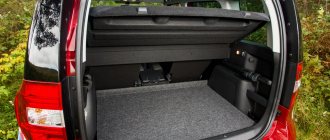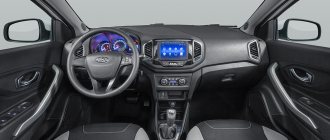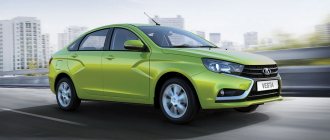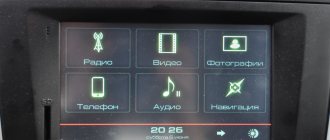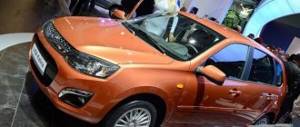Vesta or creta
Among the advantages are the stability and reliability of the suspension, good maneuverability, and comfort in the cabin due to heating.
The ergonomics of the car itself and its handling are excellent. They speak negatively about the relatively low ground clearance, inconvenient seat adjustment, and backlighting. A comparative analysis shows that the Lada Vesta SW Cross is lighter (weight – 1300 kg) and cheaper than the Hyundai. It wins in terms of trunk and interior space, higher ground clearance, and relative ease of maintenance. This is the choice of the economical driver. But car enthusiasts who are demanding about build quality and handling prefer the Hyundai Creta. Vesta or Creta - the choice is yours.
Lada Vesta Cross: universal SUV
Official Lada dealers began accepting orders for this brand last year. The first thing that attracts a car is its appearance. It is made in a bright orange color, in a modern style, so it does not look like domestic cars.
Lada Vesta SW Cross is equipped with a 1.8 liter, 122 hp petrol engine. Fuel - AI 92. This is a 5-door car with 5 seats. Its characteristics are as follows:
- gearbox – 5-speed manual;
- front-wheel drive;
- trunk – 480 l;
- acceleration to 100 km in 11.2 seconds;
- ground clearance - 203 mm.
The average cost of a car is 795,900 rubles. Motorists highly appreciate the appearance of this Lada brand. Other advantages include low-cost maintenance, stable operation of the manual transmission, ease of operation, ease of disembarking/embarking passengers, and a large cooled interior.
But some car owners are distrustful of domestic brands, noting the poor quality of the box compared to foreign analogues. Among the disadvantages are high fuel consumption (up to 11 liters when driving around the city), slow engine operation, its sensitivity to the quality of gasoline, and fragility of glass.
To understand whether the Lada Vesta SW Cross to the Hyundai Creta , you need to understand the features of the second brand. On car enthusiast forums, these two cars are compared, because they are similar in many ways. But there are significant differences between them.
Article on the topic - Duster or Creta.
Box
All modifications of Hyundai Creta are equipped with front-wheel drive. A six-speed manual transmission of the M6СF1 series is installed only with a 1.6-liter engine. The Korean mechanics are highly stable. The automatic transmission of the Hyundai Creta has six gear stages. The main values of the Creta automatic transmission are:
- Longevity;
- Exceptional dynamics;
- Low fuel consumption.
All-wheel drive is a privilege of a car with a two-liter engine. The rear multi-link transmission helps the Creta move confidently on any road, accurately take turns, maintain direction, and not sway when driving over bumps and ruts.
The Creta with front-wheel drive is less stable when driving in a straight line and avoids curves worse. Rear suspension lacks energy. She goes through pits and slides with less diligence.
New Lada: Updated robotic gearbox AMT 2.0 on Lada Vesta
Lada Vesta Cross leaves the factory with two transmission devices: 5MKPP, Robot - 5AMT. A robotic gearbox is an average version between an automatic transmission and a manual transmission. With AMT, there is no need for warming up.
Appearance
Here I would like to remain silent altogether, since, as they say, all markers are different in taste and color... In the case of Vesta SV Cross and Creta, everything is exactly the same. The Creta is made in a modern Asian style - sloping body lines, stretched headlights, a massive radiator grille. In general, everything that is typical of a modern crossover. Vesta SV Cross, on the contrary, is made in the now fashionable X-design. ICS can be traced almost everywhere. Personally, it seems to me that the face of the car is a little reminiscent of modern Lexuses... But this is just my association. Yeah, the Lada Vesta SV Cross certainly doesn’t lack for charisma. I would also like to note that both cars have a plastic protective body kit made of black plastic.
Comparison of bodies and wheelbases
General dimensions of a Korean car:
- 4.270 x 1.780 x 1.63 m;
- Base - 2,590 m;
- Ground clearance - 0.19 m.
The first copies of Korean cars sold had problems with paintwork. According to manufacturers' assurances, the problem with coating destruction has been resolved in current production vehicles. Galvanized steel sheets with a guaranteed anti-rust coating are used for the body of the Creta. The height of the metal section is from 0.6 - 0.8 mm. Build quality is generally okay.
Specifications
It is this round that is largely decisive in the debate, which is better, Lada X-Ray or Hyundai Creta? Both models offer 2 engines, and none have diesel engines, as well as 2 types of gearboxes. However, there are significant differences in this regard.
Engines
For the domestic hatchback, the line opens with the 1.6-liter, 106-horsepower VAZ-21129 engine, created by AvtoVAZ engineers. The injector and transverse arrangement in the engine compartment provide it with a peak power at 5800 rpm. And the maximum torque of 148 Nm is achievable at 4200 rpm.
The maximum speed is low - 174 km/h, and the dynamics are average - 11.4 seconds. up to a hundred. On the other hand, the fuel consumption of LADA XRAY, even in the city, is only a little more than 9 liters.
1.6 liter X Ray engine
Hyundai Creta responds with its own 1.6-liter power unit, but already 123-horsepower. This is also an injection 16-valve engine that produces peak power at 6300 rpm and its 151 Nm of torque at 4850 rpm.
Despite the advantage of 17 hp. s., in dynamics the Hyundai Creta is worse than the Lada X-Ray - 12.3 sec. when changing hundreds and only 169 km/h maximum speed. Fuel consumption is about the same.
Hyundai Creta 1.6 l
Next comes the top-end 1.8-liter engine for X-Ray - a new development of the domestic concern, although its layout remains familiar to everyone - an in-line engine with 16 valves and 4 cylinders. It already produces 122 hp. With. at 6400 rpm, allowing you to accelerate to 100 km/h in 10.4 seconds, reaching a maximum of 185 km/h. The hatchback's fuel consumption remains the same - 9.3 liters in the city.
And this is a 1.8-liter AvtoVAZ unit
The Creta can respond with a 2-liter, 150-horsepower engine with a light alloy cylinder block. In addition, there is evidence that in reality the engine is more powerful and produces up to 167 hp. s., however, in Russia its power is indicated at 150 horses in order to avoid overpayment of transport tax.
Be that as it may, it develops maximum power at 6200 rpm, and maximum torque of 192 Nm is available at 4200 rpm. With such an engine, the Creta is almost equal to the Lada in terms of dynamics - 10.7 seconds, with a limit of 183 km/h. But consumption per 100 km is almost a liter higher – 10.2 liters.
Hyundai Creta 2.0, 150 l. With.
As you can see, the engines of the Korean crossover are more technologically advanced and develop more power. However, the dynamic characteristics of the Hyundai Creta are worse than those of the Lada X-Ray. The reason lies not only in the greater mass of the Korean SUV, but also in the higher revs when this same power is achieved. In addition, the Creta's 2-liter engine is paired only with an automatic transmission, so with a manual transmission the results would quite possibly be different.
Therefore, all other things being equal, we can admit that in this round the Lada X-Ray is better than the Hyundai Creta, although the advantage is small. Of course, diesel engines would come in handy, especially in the current fuel realities, but they don’t exist.
Transmissions
In terms of gearboxes, the Hyundai Creta is better than the X-Ray. Both models have a pair of transmissions - manual and automatic. The Lada is equipped with a French-made 5-speed manual gearbox.
5-speed manual Lada X-Ray
The Creta also has a manual transmission, but with a 6-speed one. Of course, some argue that in a car with 123 hp. With. There's no need for a 6-speed gearbox under the hood, but we have to admit that the Korean transmission looks better.
Creta 6-speed manual transmission
As for automatic nodes, the companies took different paths. The Lada X-Ray is equipped with a 5-band robotic transmission of the AMT type, developed on the basis of the 21826 manual transmission. It was chosen by the plant for economic reasons, since the robot is cheaper than a classic torque converter.
5-speed robot AMT X Ray
The Hyundai Creta is equipped with a full-fledged 6-speed automatic transmission, thanks to which it confidently wins this round. Yes, the robot has its advantages, primarily in maintenance. However, driving comfort with an automatic transmission is undoubtedly higher - there are more gears, and the shifts are smoother. This means that in the question of which is better, the Lada X-Ray or the Hyundai Creta, the Korean is stronger.
6-speed automatic transmission Hyundai Creta
Chassis
In this regard, the Hyundai Creta is confidently in the lead due to 2 points. Lada X-Ray is equipped only with a semi-independent suspension design, with MacPherson struts at the front and a torsion beam at the rear axle. As for the Creta, all its versions, except the top one, are equipped with the same suspension. But the modification with an automatic transmission, a 2-liter engine and all-wheel drive is equipped with a completely independent multi-link circuit.
Torsion beam X Ray
In addition, the decisive factor is the lack of all-wheel drive on the LADA XRAY. It is because of this that many do not want to recognize a domestic car as a crossover, characterizing it simply as an all-terrain hatchback. Of course, in some situations the presence of a switchable traction control system is very helpful, as demonstrated in one of the episodes of “Okay Mechanics”.
However, switchable ESC cannot replace all-wheel drive. Consequently, the Creta’s off-road capabilities are still higher. As for handling, both cars have it at a high level. The cars hold the road well, do not skid when turning, body roll is small, as is the wave buildup. And yet, the Hyundai Creta is better in driving than the Lada X-Ray, although it cannot be said that the advantage of the Korean SUV is overwhelming.
Creta chassis
Price for minimum and maximum configurations
The cost of the Hyundai Creta 1.6L 6MT 2WD in the smallest Start configuration is 879,900 rubles. Even in basic equipment, the Creta has front airbags for the driver and front passenger. The price of a fully equipped Hyundai Creta Travel with a two-liter engine and automatic transmission is set at 1,307,900 rubles.
Not a big price for Ladas in the initial configuration: they are equipped with a 1.6 liter engine and a manual transmission. The price with a minimum configuration is 770,900 rubles. With a full load of options and a 1.8 liter engine, the price of Vesta increases to 866,900 rubles.
Comparison of configurations and prices
Despite the bright appearance and excellent level of equipment, the new products belong to the budget segment. There are six trim levels for Creta: Start, Comfort, Active, Travel, Brown Pak and Bi-2. The higher the price, the more equipment will be on board. The minimum price tag starts from 982,000 rubles. The flagship assembly of the new product reaches 1.559 million rubles, the list of equipment of which includes:
- halogen and LED optics;
- heating and drive mirrors;
- engine start button;
- keyless entry;
- cruise and climate control;
- 7-inch LCD monitor;
- rear view camera, etc.
The limited edition Bi-2 stands out. A total of one thousand cars will be produced. This version includes a two-tone body paint, a spoiler, a welcome logo, 17-inch black alloy wheels and a diffuser.
Due to government support, X-Ray managed to “bring down” the price to a minimum. There are six trim levels in total - Classic, Classic Optima, Comfort, Luxury, Luxury Prestige, Instinct. Starting price – 784,000 rubles. Of course, in this case you shouldn’t count on a premium. A much more comfortable package costing just over a million. The list of flagship equipment includes:
- halogen headlights;
- LED DRLs;
- drive, heated mirrors;
- combined interior trim;
- Remote control central locking;
- heated steering wheel and windshield;
- rear parking sensors;
- Cruise control;
- climate control;
- 8-inch monitor;
- navigation, rear view camera, etc.
As a result, the equipment of the first one is close to the Russian hatchback, but the price differs so much that it feels like a complete overpayment for the brand. At the same time, experts note that the quality of the two options is at an equally high level.
Fuel consumption
It doesn’t matter whether it’s a Hyundai Creta or a Lada X-Ray Cross , it will still have to be refueled, so it’s important to evaluate fuel costs before purchasing. The first one received a standard set for Korean production - 1.6 and 2.0-liter engines, so the consumption here is quite known. The younger one is available with automatic and manual transmission. At the same time, he has the ability to select a drive. It will spend from 7.0 to 7.6 liters depending on the selected parameters. The older one will inevitably be equipped with an automatic transmission. With front-wheel drive, the “appetite” per hundred kilometers is 7.5 liters, and for all-wheel drive it is 8.0. A manual transmission and a 1.8-liter X-Ray gasoline engine consumes 7.5 liters of gasoline per hundred kilometers in the combined cycle. CVT and 1.6-liter engine - 7.3 liters. Thus, both models are economical and suitable for city trips.



